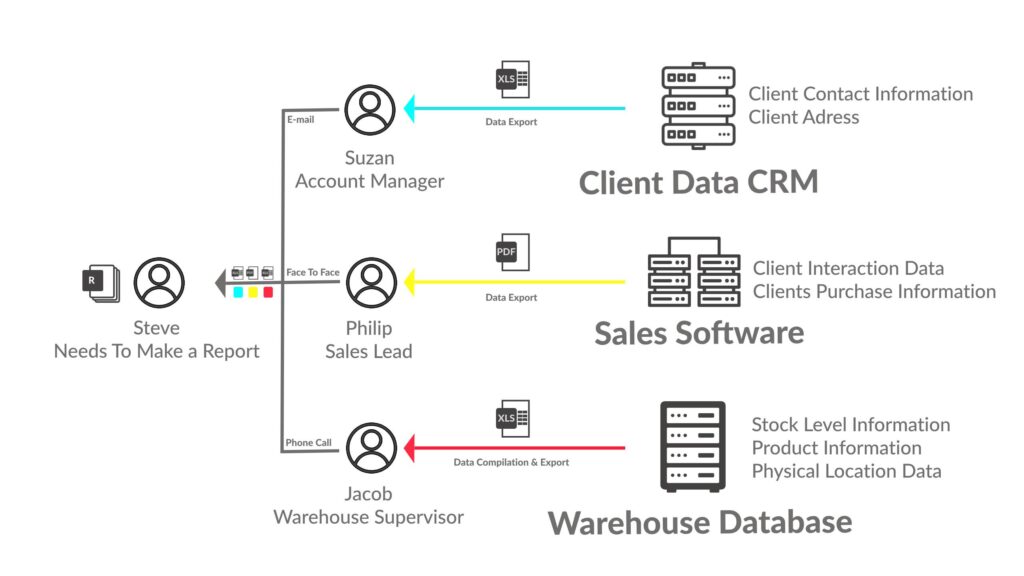Siloed Systems & Data
Quite often scenarios occur where a few systems are standing divided and completely separated from each other. Without communicating together or being linked in any fashion, a data silo.





Data silo's & stand alone legacy systems overview
A “Data Silo” is a reference often used to describe a storage of data or information that’s completely cut off from the larger organization. So it’s potentially a system with valuable data that you are not getting, or a duplicate source of information in some cases. For example, you have a piece of stock-keeping software that’s used to keep the warehouse running smoothly. But then there is also the software package that takes care of invoicing, customer data, and such information.
A data silo hinders company wide effectiveness
Because they are not connected, getting conclusive data is quite a choir. Because it involves a lot of “leg work”. But it can also mean one department is basing their actions on one system, while management is looking at the same category of data, but provided by another system. Which can lead to confusion, chaos, and even some pointed discussions.
Overcoming a data silo often requires a lot of time from an employee
Often someone has to go to the various departments, or log in to various systems and pull out the information that they need to make their report. But this can be more difficult than just putting all of the separate information from various systems into one file. If both systems store similar types of data and overlap the data would have to be sorted and compiled into one definitive form before it can be used for anything.
Manual Cross Departmental Data Integration Can Be Very Time Consuming
It can also be one step more complicated when there are key figures in for example different departments who have the oversight over various processes or access or knowledge of certain programs that need to provide information. In this scenario someone needs to go around and then ask the next person to put time and effort into this, making the whole procedure more ineffective. Also; the person who has the access can be on holiday or ill at one point, and then the system that needs to divulge the information will just not be accessible. Slowing the whole process of gathering meaningful information down to a standstill.
A Scenario: Multiple Siloed Systems

Meet Steve, Steve often finds himself in a position where he has to make reports for management, or perhaps an offering for an important client. To do this he needs up-to-date information from various sources. In this case, he needs the client’s data, the specifics of what they want to buy. And the company’s current access and stock of the items in question. The issue is that all systems are stand alone systems, meaning they are effectively data silos.
Data silo 1: Get the clients special rates, local contact, and delivery address.
But Steve’s life is not as easy as it could be. Getting all the info he needs to compile the document he needs to create requires 3 people with access to systems to cooperate with him and hand him the data. First, he emails Suzan the account manager, and requests all the information about the clients, and delivery address. The agreed-upon discount, and checks up on any special conditions this account might have. Suzan makes some time for this pretty fast and sends him the data in 20 minutes an export for him and sends him an XLS file, or spreadsheet.
Data silo 2: Get the offering details from the ever busy sales department.
Next up in Steve’s quest for data is Philip, the person in charge of sales. Philip is a little busy as they need to hit some targets and Steve has to go up to Sales twice to get a PDF file which is not the easiest to work with, but Steve is a recourseful guy so he manages in the end.
Data silo 3: get info on stock levels, delivery dates and so on from a Legacy Inventory System.
Lastly, Steve calls Jacob over in the warehouse. Because he needs the particulars of what they will have in stock and when, and Jacob also has access and understanding of some of the older and rough around the edges warehouse software. A few hours later Jacob sends the info Steve needs in the form of a not to greatly parsed XLS file. Undaunted, Steve continues to make his report and can succeed in his task today.
Same Scenario: But with a complication

The fragility of data silos and stand alone legacy systems exposed:
A few weeks later, and a few reports without incident down the line. Steve is up to his regular work of meeting with everyone and gathering information from departments he needs to inform stakeholders what is possible, and when. Jacob has caught a particularly viral flue bug and is off sick for at least the coming week. This is a huge problem for Steve as no one else can access the warehouse database and get the info he needs. Steve now just has to guess delivery dates and stock levels or tell the stakeholders to wait at least a week, not an ideal scenario that could be avoided by better integration and dashboards.
Conclusions we can gleam from this scenario:
-
Ineffective: It’s pretty time-consuming for Steve to go around and gather this info, costing the company a lot of man-hours. Not just from Steve, but also the department heads or points of contact.
-
Fragile: It’s quite easy for this structure to break and have a bottleneck that prevents people access to information when they need it.
-
Exploitable: People having to ask for info is also great for “Phishing” hackers that rely on impersonating employees to have others give them information willingly.
In this case, some bespoke software and or a Dashboard would greatly improve overall security, and efficiency and save some manhours. So reach out to us today and we can review your situation.
Common Questions about Data Silo's
What are the security risks of merging data?
Can we change this without disrupting operations?
How will this effect data governance?
How do we intergrate these silos?
Can we handle this internally or do we need specialist?
data silos are more common then you might think.
Do you recognize this situation?
Dashcoon can help you become more efficient and streamline this situation for your company!